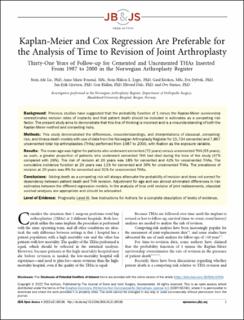| dc.contributor.author | Lie, Stein Atle | |
| dc.contributor.author | Fenstad, Anne Marie | |
| dc.contributor.author | Lygre, Stein Håkon Låstad | |
| dc.contributor.author | Kroken, Gard | |
| dc.contributor.author | Dybvik, Eva Hansen | |
| dc.contributor.author | Gjertsen, Jan-Erik | |
| dc.contributor.author | Hallan, Geir | |
| dc.contributor.author | Dale, Håvard | |
| dc.contributor.author | Furnes, Ove Nord | |
| dc.date.accessioned | 2022-08-16T06:59:10Z | |
| dc.date.available | 2022-08-16T06:59:10Z | |
| dc.date.created | 2022-05-14T21:34:31Z | |
| dc.date.issued | 2022 | |
| dc.identifier.issn | 2472-7245 | |
| dc.identifier.uri | https://hdl.handle.net/11250/3011995 | |
| dc.description.abstract | Background: Previous studies have suggested that the probability function of 1 minus the Kaplan-Meier survivorship overestimates revision rates of implants and that patient death should be included in estimates as a competing risk factor. The present study aims to demonstrate that this line of thinking is incorrect and is a misunderstanding of both the Kaplan-Meier method and competing risks.
Methods: This study demonstrated the differences, misunderstandings, and interpretations of classical, competing-risk, and illness-death models with use of data from the Norwegian Arthroplasty Register for 15,734 cemented and 7,867 uncemented total hip arthroplasties (THAs) performed from 1987 to 2000, with fixation as the exposure variable.
Results: The mean age was higher for patients who underwent cemented (72 years) versus uncemented THA (53 years); as such, a greater proportion of patients who underwent cemented THA had died during the time of the study (47% compared with 29%). The risk of revision at 20 years was 18% for cemented and 42% for uncemented THAs. The cumulative incidence function at 20 years was 11% for cemented and 36% for uncemented THAs. The prevalence of revision at 20 years was 6% for cemented and 31% for uncemented THAs.
Conclusions: Adding death as a competing risk will always attenuate the probability of revision and does not correct for dependency between patient death and THA revision. Adjustment for age and sex almost eliminated differences in risk estimates between the different regression models. In the analysis of time until revision of joint replacements, classical survival analyses are appropriate and should be advocated. | en_US |
| dc.language.iso | eng | en_US |
| dc.publisher | Journal of Bone and Joint Surgery | en_US |
| dc.rights | Attribution-NonCommercial-NoDerivatives 4.0 Internasjonal | * |
| dc.rights.uri | http://creativecommons.org/licenses/by-nc-nd/4.0/deed.no | * |
| dc.title | Kaplan-Meier and Cox Regression Are Preferable for the Analysis of Time to Revision of Joint Arthroplasty: Thirty-One Years of Follow-up for Cemented and Uncemented THAs Inserted from 1987 to 2000 in the Norwegian Arthroplasty Register | en_US |
| dc.type | Journal article | en_US |
| dc.type | Peer reviewed | en_US |
| dc.description.version | publishedVersion | en_US |
| dc.rights.holder | Copyright 2022 the authors | en_US |
| dc.source.articlenumber | e21.00108 | en_US |
| cristin.ispublished | true | |
| cristin.fulltext | original | |
| cristin.qualitycode | 1 | |
| dc.identifier.doi | 10.2106/JBJS.OA.21.00108 | |
| dc.identifier.cristin | 2024633 | |
| dc.source.journal | JBJS Open Access | en_US |
| dc.identifier.citation | JBJS Open Access. 2022, 7 (1), e21.00108. | en_US |
| dc.source.volume | 7 | en_US |
| dc.source.issue | 1 | en_US |

